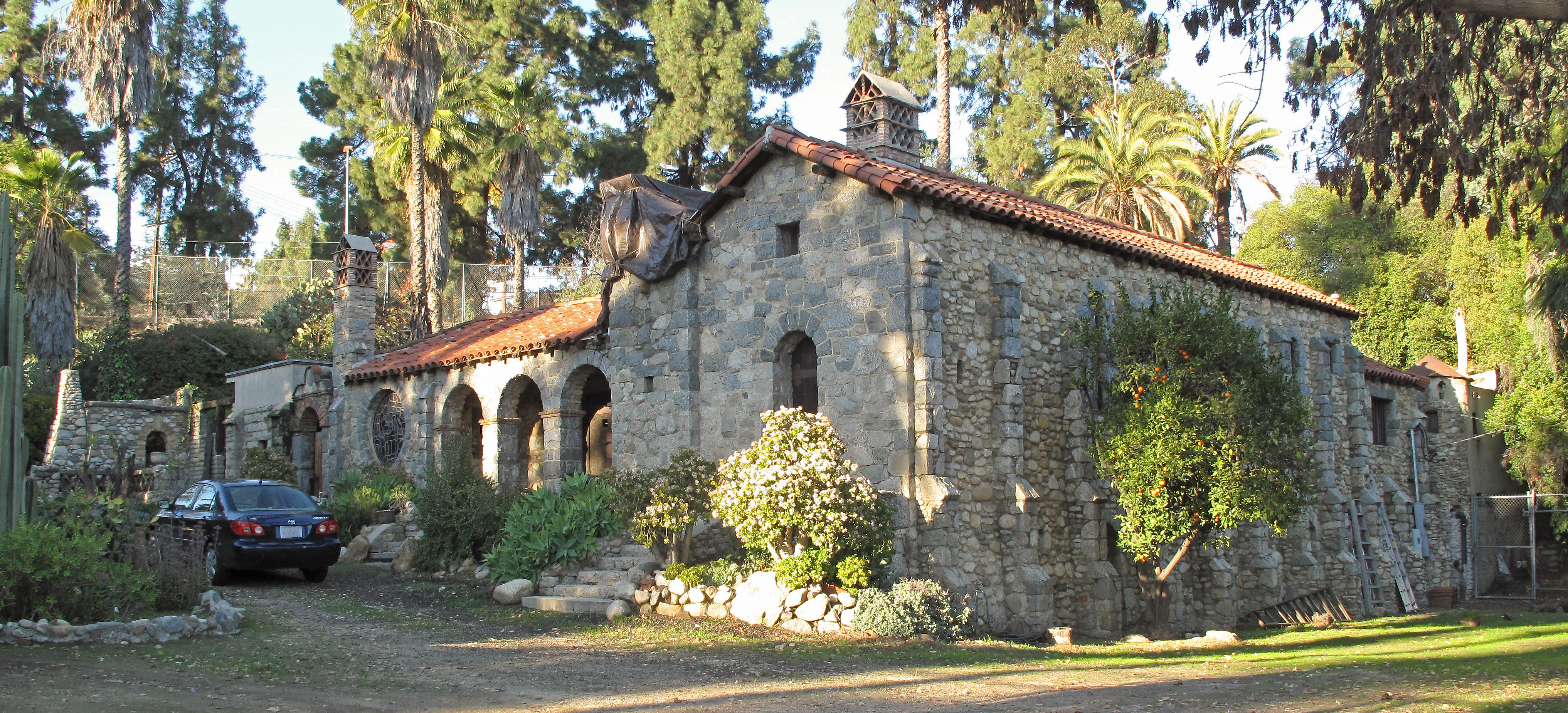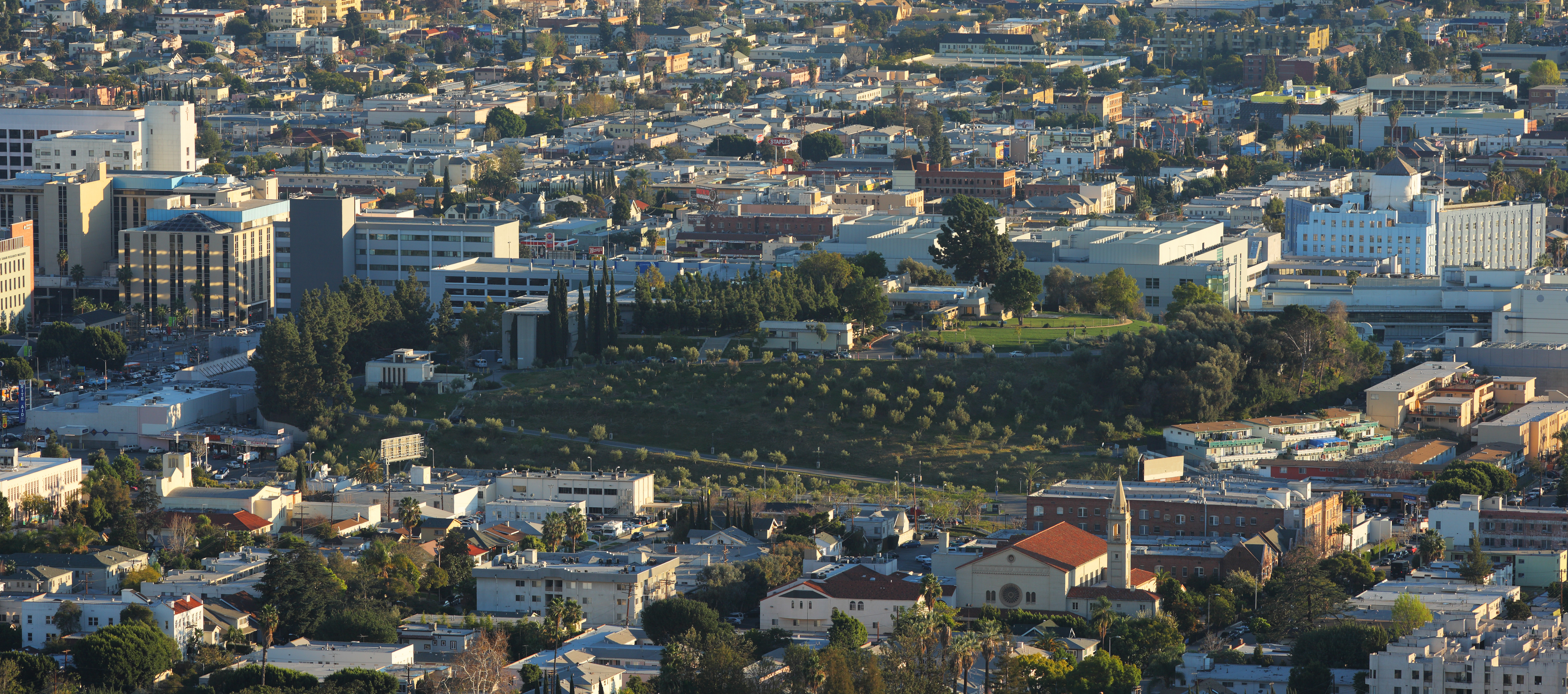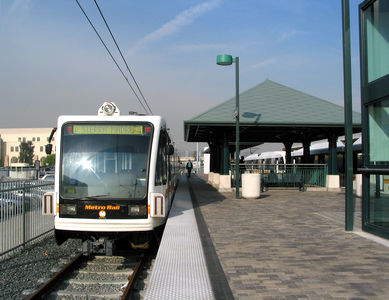|
Judson Studios
Judson Studios is a fine arts studio specializing in stained glass located in the Highland Park section (also known as Garvanza) of northeast Los Angeles. The stained glass studio was founded in the Mott Alley section of downtown Los Angeles in the mid-1890s by English-born artist William Lees Judson and his three sons. It moved to its current location in 1920 and remains in operation as a family-run business. The Judson Studios building was named a Historic-Cultural Landmark by the City of Los Angeles in 1969 and listed in the National Register of Historic Places in 1999. Founder William Lees Judson William Lees Judson was born in 1842 in Manchester, England, and moved to the United States with his parents when he was ten years old. After serving four years with the Illinois volunteers during the American Civil War, Judson studied art in New York and Paris. He settled in London, Ontario, where he became a successful portrait painter and art teacher. He moved to Chicago i ... [...More Info...] [...Related Items...] OR: [Wikipedia] [Google] [Baidu] |
Highland Park, Los Angeles, California
Highland Park is a neighborhood in Los Angeles, California, located in the city's Northeast region. It was one of the first subdivisions of Los Angeles and is inhabited by a variety of ethnic and socioeconomic groups. History The area was settled thousands of years ago by Paleo-Indians, and would later be settled by the Kizh. After the founding of Los Angeles in 1781, the Corporal of the Guard at the Mission San Gabriel Arcángel, Jose Maria Verdugo, was granted the 36,403 acre Rancho San Rafael which included present day Highland Park. Drought in the mid-19th century resulted in economic hardship for the Verdugo family, which eventually compelled them to auction off Rancho San Rafael in 1869 for $3,500 over an unpaid loan. The San Rafael tract was purchased by Andrew Glassell and Albert J. Chapman, who leased it out to sheep herders. In 1885, during the 1880s land boom, it was sold to George Morgan and Albert Judson, who combined it with other parcels they had purchased from ... [...More Info...] [...Related Items...] OR: [Wikipedia] [Google] [Baidu] |
Greene And Greene
Greene and Greene was an architectural firm established by brothers Charles Sumner Greene (1868–1957) and Henry Mather Greene (January 23, 1870 – October 2, 1954), influential early 20th Century American architects. Active primarily in California, their houses and larger-scale ultimate bungalows are prime exemplars of the American Arts and Crafts Movement. Biographies Charles Sumner and Henry Mather Greene were born in Brighton, Ohio, in 1868 and 1870, respectively. They grew up primarily in St. Louis, Missouri, and on their mother's family farm in West Virginia while their father attended medical school. As teenagers, the brothers studied at the Manual Training School of Washington University in St. Louis, where they studied metal- and woodworking and graduated in 1887-1888. Their father, a practicing homeopathic physician by this time, was very concerned with the need for sunlight and circulating fresh air; the importance of these elements was to become one of the signatu ... [...More Info...] [...Related Items...] OR: [Wikipedia] [Google] [Baidu] |
World War I
World War I (28 July 1914 11 November 1918), often abbreviated as WWI, was one of the deadliest global conflicts in history. Belligerents included much of Europe, the Russian Empire, the United States, and the Ottoman Empire, with fighting occurring throughout Europe, the Middle East, Africa, the Pacific, and parts of Asia. An estimated 9 million soldiers were killed in combat, plus another 23 million wounded, while 5 million civilians died as a result of military action, hunger, and disease. Millions more died in genocides within the Ottoman Empire and in the 1918 influenza pandemic, which was exacerbated by the movement of combatants during the war. Prior to 1914, the European great powers were divided between the Triple Entente (comprising France, Russia, and Britain) and the Triple Alliance (containing Germany, Austria-Hungary, and Italy). Tensions in the Balkans came to a head on 28 June 1914, following the assassination of Archduke Franz Ferdin ... [...More Info...] [...Related Items...] OR: [Wikipedia] [Google] [Baidu] |
Louis Comfort Tiffany
Louis Comfort Tiffany (February 18, 1848 – January 17, 1933) was an American artist and designer who worked in the decorative arts and is best known for his work in stained glass. He is the American artist most associated with the Art NouveauLander, David"The Buyable Past: Quezal Glass" ''American Heritage'' (April/May 2006) and Aesthetic movements. He was affiliated with a prestigious collaborative of designers known as the Associated Artists, which included Lockwood de Forest, Candace Wheeler, and Samuel Colman. Tiffany designed stained glass windows and lamps, glass mosaics, blown glass, ceramics, jewellery, enamels, and metalwork. He was the first design director at his family company, Tiffany & Co., founded by his father Charles Lewis Tiffany. __TOC__ Early life Louis Comfort Tiffany was born in New York City, the son of Charles Lewis Tiffany, founder of Tiffany and Company, and Harriet Olivia Avery Young. He attended school at Pennsylvania Military Academy in West ... [...More Info...] [...Related Items...] OR: [Wikipedia] [Google] [Baidu] |
Frederick Wilson (artist)
Frederick Wilson (3 November 1858 - 24 March 1932) was a British stained glass artist best known for his work with Tiffany Studios. He was a prominent designer of ecclesiastical windows in the United States during the late 19th and early 20th centuries. Biography Frederick Wilson was born in Dublin, Ireland to English parents, Charles and Elizabeth Wilson. The family eventually moved to England and Wilson and his six siblings were raised in both Liverpool and London. Although little is known about Wilson's early artistic education, there is evidence that he attended the South Kensington School, which was associated with the South Kensington Museum (now known as the Victoria and Albert Museum). In 1891, Wilson married Mary Gwladys Morgan, and the following year they immigrated to the United States. The couple had three children: Gladys, Sylvia and Beatrice. Career Frederick Wilson's career designing stained glass spanned more than 50 years. He was "known and accepted as an ... [...More Info...] [...Related Items...] OR: [Wikipedia] [Google] [Baidu] |
Barnsdall Art Park
Barnsdall Art Park is a city park located in the East Hollywood district of Los Angeles, California. Parking and arts buildings access is from Hollywood Boulevard on the north side of the park. The park is a Los Angeles Historic-Cultural Monument, and a facility of the City of Los Angeles Department of Cultural Affairs. Aline Barnsdall donated Barnsdall Park to the City of Los Angeles for arts and recreational purposes, including the preservation of the historic architecture and landscape features. Located at the crest of Olive Hill, Barnsdall Art Park overlooks the city of Los Angeles, and the Hollywood Hills, including Griffith Park. The park is centered on Barnsdall's Hollyhock House designed by architect Frank Lloyd Wright, a National Historic Landmark, Los Angeles Historic-Cultural Monument, World Heritage Site, and on the National Register of Historic Places in Los Angeles. History Aline Barnsdall, a native of Bradford, Pennsylvania and heiress to an oil fortune, was led by ... [...More Info...] [...Related Items...] OR: [Wikipedia] [Google] [Baidu] |
Ennis House
The Ennis House is a residential dwelling in the Los Feliz neighborhood of Los Angeles, California, United States, south of Griffith Park. The home was designed by Frank Lloyd Wright for Charles and Mabel Ennis in 1923 and was built in 1924. Following '' La Miniatura'' in Pasadena, and the Storer and Freeman Houses in the Hollywood Hills of Los Angeles, the structure is the fourth and largest of Wright's textile block designs, constructed primarily of interlocking pre-cast concrete blocks, in the northern Los Angeles area. The design is based on ancient Maya temples, and along with other buildings by Frank Lloyd Wright, such as the A. D. German Warehouse in Wisconsin and Aline Barnsdall Hollyhock House in Hollywood, the Ennis House is sometimes referred to as an example of the Mayan Revival architecture. Its prominent detail is the relief ornamentation on its 27,000 perforated and patterned decomposed granite blocks,James McClain (October 16, 2019)Frank Lloyd Wright’s Ennis ... [...More Info...] [...Related Items...] OR: [Wikipedia] [Google] [Baidu] |
Frank Lloyd Wright
Frank Lloyd Wright (June 8, 1867 – April 9, 1959) was an American architect, designer, writer, and educator. He designed more than 1,000 structures over a creative period of 70 years. Wright played a key role in the architectural movements of the twentieth century, influencing architects worldwide through his works and hundreds of apprentices in his Taliesin Fellowship. Wright believed in designing in harmony with humanity and the environment, a philosophy he called organic architecture. This philosophy was exemplified in Fallingwater (1935), which has been called "the best all-time work of American architecture". Wright was the pioneer of what came to be called the Prairie School movement of architecture and also developed the concept of the Usonian home in Broadacre City, his vision for urban planning in the United States. He also designed original and innovative offices, churches, schools, skyscrapers, hotels, museums, and other commercial projects. Wright-designed inter ... [...More Info...] [...Related Items...] OR: [Wikipedia] [Google] [Baidu] |
Hollywood Freeway
The Hollywood Freeway is one of the principal freeways of Los Angeles, California (the boundaries of which it does not leave) and one of the busiest in the United States. It is the principal route through the Cahuenga Pass, the primary shortcut between the Los Angeles Basin and the San Fernando Valley. It is considered one of the most important freeways in the history of Los Angeles and instrumental in the development of the San Fernando Valley. It is the second oldest freeway in Los Angeles (after the Arroyo Seco Parkway). From its southern end at the Four Level Interchange to its intersection with the Ventura Freeway in the southeastern San Fernando Valley (the Hollywood Split), it is signed as part of U.S. Route 101. It is then signed as State Route 170 (SR 170) north to its terminus at the Golden State Freeway (Interstate 5). Route description The freeway runs from the Four Level Interchange in downtown Los Angeles to the Golden State Freeway in the Sun Valley distric ... [...More Info...] [...Related Items...] OR: [Wikipedia] [Google] [Baidu] |
Union Station (Los Angeles)
Los Angeles Union Station is the main train station, railway station in Los Angeles, California, and the largest railroad passenger terminal in the Western United States. It opened in May 1939 as the Los Angeles Union Passenger Terminal, replacing La Grande Station and Central Station, Los Angeles, Central Station. Approved in a controversial ballot measure in 1926 and built in the 1930s, it served to consolidate rail services from the Union Pacific, Atchison, Topeka and Santa Fe Railway, Santa Fe, and Southern Pacific Transportation Company, Southern Pacific Railroads into one terminal station. Conceived on a grand scale, Union Station became known as the "Last of the Great Railway Stations" built in the United States. The structure combines Art Deco, Mission Revival Style architecture, Mission Revival, and Streamline Moderne style. It was placed on the National Register of Historic Places in 1980. Today, the station is a major transportation hub for Southern California, servin ... [...More Info...] [...Related Items...] OR: [Wikipedia] [Google] [Baidu] |
Olvera Street
Olvera Street (also ''Calle Olvera'' or ''Placita Olvera'', originally Calle de los Vignes, Vine Street, and Wine Street) is a historic street in downtown Los Angeles, and a part of El Pueblo de Los Angeles Historic Monument, the area immediately around the 19th-century Los Angeles Plaza, which has been the main square of the city since the early 1820s, when California was still part of Mexico, and was the center of community life until the town expanded in the 1870s. Many of the Plaza District's historic buildings are on Olvera Street, including its oldest one, the Avila Adobe, built in 1818; the Pelanconi House built in 1857; and the Sepulveda House built in 1887. Restaurants, vendors, and public establishments are along the pedestrian mall, a block-long narrow, tree-shaded, brick-lined marketplace where some merchants are descended from the original vendors who opened shops when a then-decrepit Olvera Street was recreated as a tourist attraction in 1930, a romanticized versi ... [...More Info...] [...Related Items...] OR: [Wikipedia] [Google] [Baidu] |







